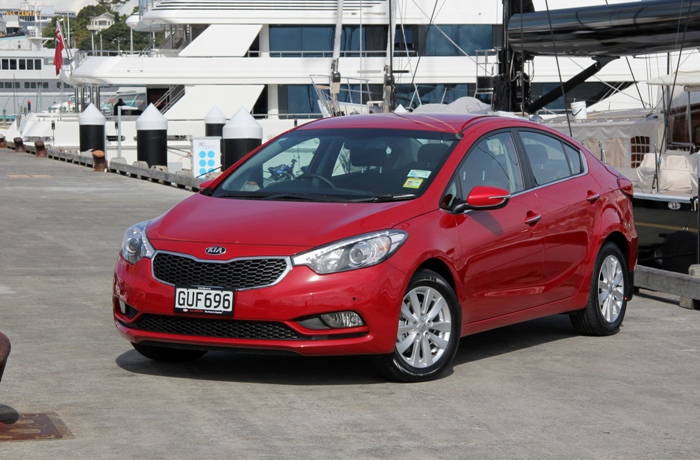
Car reviews
Read our expert car reviews - where we give insight into the latest vehicles to hit our roads.
03 May 2013
Pencilled in the USA and built in Korea, the third-generation Cerato is instantly recognizable as part of Kia’s family with its familiar tiger nose grille. The body shape closely resembles its bigger sibling, Optima while the side angle hints of its sister company’s Elantra and at the rear a sleek set of tail lights provide an elegant look, unique to the Cerato.

Globally the Cerato is the leading Kia model with more than 2.5 million vehicles sold since its inception in 2004. In New Zealand buyer preference sways towards SUVs and it’s the Sportage that’s currently at the top of the sales leader board for the Korean brand. The Cerato slots into the small sedan segment’s tiny 3.8% share of the new car market in NZ.
Pencilled in the USA and built in Korea, the third-generation Cerato is instantly recognizable as part of Kia’s family with its familiar tiger nose grille. The body shape closely resembles its bigger sibling, Optima while the side angle hints of its sister company’s Elantra and at the rear a sleek set of tail lights provide an elegant look, unique to the Cerato.
The body has grown longer, wider and lower while the wheelbase increased by 50mm, equal to that of the larger Sorento SUV. The extensive use of higher tensile steels improves torsional rigidity and shaves 70kg off the body weight, while the flowing design improves aerodynamic efficiency as well.
The Cerato offers a decent amount of roominess for its class and the subtle dashboard design along with a respectable 421L of luggage space is appealing too.
Two new petrol engines are available with the previous models 'Theta' engines dropped in favour of Kia's 'Nu' 1.8L and 2.0L range of powerplants. The 2.0L GDI (gasoline direct injection) motor has outputs of 129kW/209Nm while the 1.8L engine uses the traditional port injection fuel delivery and produces 110kW/178Nm. The 1.8L motor performs well enough, but the 2.0L offers a marginal performance gain, with fuel economy claimed to be 7.4L/100km for the 2.0L and 7.1L/100km for the 1.8L.
Due to the reduction in body weight the new 1.8L has an almost identical power to weight ratio as the previous 2.0L model. The 'Nu' 2.0L motor will also be fitted to the 2013 Cee’d when it arrives later in the year as well as the 2014 Sportage models.
All engines are coupled to six-speed automatic transmissions while a stick shift option is available on indent order at the same price as the auto models.
Kia’s engineers carried out extensive testing across the Tasman and in New Zealand’s Otago region to tweak the McPherson strut front and rear torsion beam suspension to better suite local conditions. The suspension received different struts and upgraded spring rates compared with other markets and the electrically-assisted steering received new software calibration.
The Flex-Steer system, that’s been available on Hyundai's i30 and Santa Fe, is now fitted to Cerato. The system allows the driver to tweak the steering weight to one of three settings; Normal, Comfort and Sport. The Comfort setting’s light feel makes parking effortless while the Sport mode has a nicely weighted turning effort that enthusiastic drivers will appreciate. The steering rack has moved forward and the suspension's castor geometry is unchanged, which Kia claims is favourable for steering self centre and feel, although this was not evident during our test drive.
The Cerato is available in three specification levels; LX, EX and SX. The base model 1.8L LX comes with front fog lamps, keyless entry, front and rear proximity sensors, cruise control, steering wheel mounted audio controls and a height adjustable driver’s seat. The 1.8L EX has LED daytime running lights, auto activating headlights, touch screen audio display and a reversing camera. The 2.0L SX adds 17-inch alloys, leather trim, heated front seats as well as cooling for the driver, steering wheel mounted transmission paddle shifters, dual-zone climate control and a sunroof.
Active safety features are in the form of Vehicle Stability Management (VSM), Electronic Stability Control (ESC), Brake Assist System (BAS), Traction Control System (TCS) and Hill-start Assist Control (HAC).
Passive safety features include six airbags and seat-belt sensors for all seating positions. The previous model only managed a four-star ANCAP safety rating and although not yet tested, Kia expects the full five stars when the new model is crash tested.
The Cerato is offered in three models starting with the 1.8L LX at $29,990 and $33,490 for the 1.8L EX while the top of the range 2.0L SX is priced at $38,490.
The Cerato is one of the larger cars in its segment and even the base model has a lot of kit on offer. Kia anticipates selling between 25 -30 sedans a month and the arrival of the hatchback later in the year is forecast to boost sales by a further 50 units a month. The new Koup is expected to arrive at the end of the year.